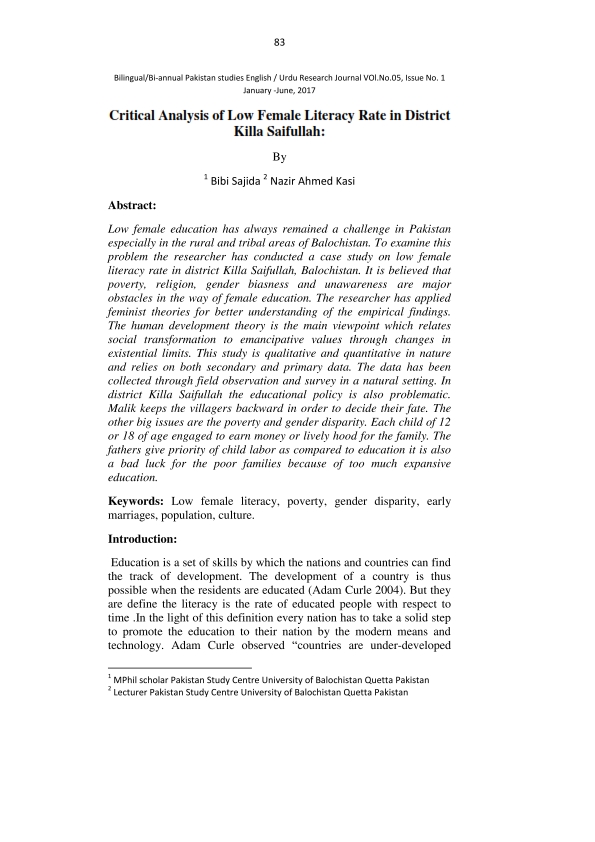Critical Analysis of Low Female Literacy Rate in District Killa Saifullah
Keywords:
Low female literacy, poverty, gender disparity, early marriages, population, culture.Abstract
Low female education has always remained a challenge in Pakistan
especially in the rural and tribal areas of Balochistan. To examine this
problem the researcher has conducted a case study on low female
literacy rate in district Killa Saifullah, Balochistan. It is believed that
poverty, religion, gender biasness and unawareness are major
obstacles in the way of female education. The researcher has applied
feminist theories for better understanding of the empirical findings.
The human development theory is the main viewpoint which relates
social transformation to emancipative values through changes in
existential limits. This study is qualitative and quantitative in nature
and relies on both secondary and primary data. The data has been
collected through field observation and survey in a natural setting. In
district Killa Saifullah the educational policy is also problematic.
Malik keeps the villagers backward in order to decide their fate. The
other big issues are the poverty and gender disparity. Each child of 12
or 18 of age engaged to earn money or lively hood for the family. The
fathers give priority of child labor as compared to education it is also
a bad luck for the poor families because of too much expansive
education.
References
Aly, J. H. (2007). Education in Pakistan. A White Paper; Document To
Debate And Finalize The National Education Policy. Ministry of
Education Pakistan.
Annual Report: Pakistan Education Statistics 2011-12, National
Education Management Information System Academy of Educational
Planning and Management, Ministry of Education, Trainings &
Standards in Higher Education, Government of Pakistan, (Islamabad,
AEPAM, 2013).
Ballara, M. (1992). Women and literacy. Atlantic Highlands, NJ: Zed
Books.
Chaudhry, I. S. and Saeed-ur-Rahman. (2009). The Impact of Gender
Inequality in Education on Rural Poverty In Pakistan: An empirical
Analysis, European Journal of Economics, Finance and Administrative
Sciences,
Chaudhry, I. S., Nosheen, F., and Lodhi, M. I. (2012). Women
Empowerment in Pakistan with Special Reference to Islamic
Viewpoint: An Empirical Study. Pakistan Journal of Social Sciences
(PJSS), 32(1), Pp: 171-183.
Chaudhry, M. A. (2005). Pakistan: where and who are the world’s
illiterates? Background paper prepared for the Education for All
Global Monitoring Report 2006; literacy for life
http://unesdoc.unesco.org/images/0014/001459/145959e.pdf .
Constitution of Islamic Republic of Pakistan, (1973). Inserted in the
constitution (18th amendment) Act 10 of 2010.
Dawn 6 June 2016. This news was published in The Nation newspaper.
Read complete newspaper of 21-Feb-2015 here.
Economic Survey of Pakistan 2014, Ministry of Finance, Government
of Pakistan.
Education for All (EFA) Global Monitoring Report 2013-14. Available
online atunesdoc.unesco.org/images/0022/002256/225660e.pdf
Gannicott, K., and Avalos, B. (1994). Women’s Education and
Economic Development in Melanesia, National Centre for
Development Studies: Canberra.
Government of Pakistan, (2002). Economic Survey of Pakistan,
Islamabad, Pakistan.
Hashmi, N., Zafar M, I., and Ali, T. (2009). Low Female Educational
Attainment in Rural Pakistan: Causes and Remedies. Pakistan Journal
of Science, 61(4), Pp: 215-219.
Human Development Index Report. (2013) the Rise of the South:
Human
Progress in a Diverse World. Available online author.undp.org /sites
/files /reports /hdr 2013 _en_complete.pdf Accessed on 06-06-2014.
Human Development Index Report. (2016). the Rise of the South:
Human Progress in a Diverse World. Available online.org/ sites/
default/ /reports/ 14/ 2013_en_complete.pdf Accessed on 06-06-2014.
Human Development Report, (2014) “Sustaining Human Progress:
Reducing Vulnerabilities and Building Resilience,” United Nations
Development Program (UNDP) (New York: UNDP, 2014).
Khalid, H. S. and Mukhtar, E. M. (2002) “The future of girls'
education in Pakistan” UNESCO Office, Islamabad, Pakistan.
Khan, G, A., Azhar, M., and Shah, S. A. (2011). Causes of Primary
School Dropout among Rural Girls in Pakistan. Working Paper Series
# 119. A publication of the Sustainable Development Policy Institute
(SDPI).
Khan, R. E. A., and Ali, K. (2005) “Bargaining over Sons’ and
Daughters’ Schooling; Probity Analysis of Household Behavior in
Pakistan”. Working Paper 01-05. Department of Economics, Islamic
University, Bahawalpur.
Mahmood, N. (2011), the Demographic Dividend: Effects of
Population Change on School Education in Pakistan, Pakistan Institute
of Development Economics Islamabad. www.pide.org.pk
Maliha Naveed, Reasons of Low Levels of Education in Pakistan,
Pakistan Herald, and January 03,
(availableat:http://www.pakistanherald.com/articles/reasons-oflow-levels-of-education-in-pakistan-3065).
Mehnaz Aziz et al, “Education System Reform in Pakistan: Why,
When, and How?” IZA Policy Paper No. 76, January 2014 (Institute
for the Study of Labor, 2014), P 4.
Memon, G. R. (2007). Education in Pakistan: The Key Issues,
Problems and the New Challenges. Journal of Management and Social
Sciences, 3(1), Pp: 47-55.
Mincer (1958, 1974), Becker (1964 and 1975) and Sehultz (1960 And
.as well as the updated summaries of this literature by Cahue and
zilberberg (2004) and Psacharopoulos and Patrinos (2007)
OECD,(2013).Education .Available online at
http://www.oecd.org/edu/eag 2013 % 20 % 28 eng % 29—FINAL
% 2020 % 20 June % 20 2013.pdf retrieved on 24-06-2014.
Pakistan Education for All 2015 National Review, Ministry of
Education, Trainings and Standards in Higher Education Academy of
Educational Planning and Management Islamabad, Pakistan June, 2014
(available at : http: //unesdoc .unesco .org/ images/ 0022/ 002297/
E.pdf).
PSLM, (2012). Pakistan Social and Living Standards Measurement
Survey.
http://unesco.org.pk/education/documents/2013/pslm/PSLM_2011-
pdf accessed on 08-06-2014.
Shahzad, S., Ali, R., Hukamdad. Ghazi, S. R., & Gillani, U. S. (2010).
Access and Equity in Basic Education. Asian Social Science.
www.ccsenet.org/ass
Toor, I. A., Parveen, R. (2004). Factors Influencing Girls’ Primary
Enrolment in Pakistan. The Lahore Journal of Economics, 9(2), Pp:
-157.
UNESCO, (2011). World Data on Education 2010-2011.7th edition.
Available online at www.ibe.unesco.org/.
UNESCO, (2012). Why Pakistan Needs a Literacy Movement?
Retrieved from the
websitehttp://unesco.org.pk/education/documents/publications/Why_P
akistan_Needs_Literacy_Movement.pdf.Retrieved on 07-06-
Sci.Int. (Lahore), 27(1), 555-559, 2015 ISSN 1013-5316;
CODEN: SINTE 8 559 Jan.-Feb.



